|
Karnak-Temple |
last update:
24.09.2009
|
| |
NTrj-mnw
and other small buildings from the time of upheaval |
|
| During the numerous excavations in Karnak many fragments from
the time of Thutmosis II, Hatschepsut, and Thutmosis III came to light.
Several limestone blocks were discovered during the excavation of the
Cachette in the court before the 7-th pylon where they had been used in the
foundation of the eastern side of the court. Today bigger blocks are
displayed in the OAM, in the southern stone camp, and in the Luxor-Museum.
|
| Gabolde (2005) has examined the numerous fragments and
reconstructed the existence of 4 lime-stone buildings erected at Karnak -
the
"NTrj
mnw = Divine Monument", a small
Chapel with niches, dedicated to the cult of
several members of the royal family, a
(Barque?-)Chapel, and at least a small chapel
of which only minor fragments have survived.
|
|
The examination of the blocks decorated with bas-relief revealed that these
buildings that they were erected during the time of upheaval when the Great
Royal Wife, God's Wife of Amun, Hatshepsut became Queen Regent for young Thutmosis III
and finally took the full power as the King of the Two Lands as Maat-ka-Ra -
a period which is less documented in the other monuments. |
| This Monument is mentioned in three texts (Larché, 2007): on a statue of
Hapuseneb,
which is dated into the reign of Thutmosis II (on this statue which is today in the Louvre, A 134,
Hapuseneb wrote: I have built a temple of beautiful white limestone (called): "Maat-ka-Ra
who is divine by [her] monuments."), on the
Red Chapel (western gate,
Block
No. 131: " Temple of Men-kheper-Ra (called): " Amun, divine by [his]
monuments"),
dating into the time of the co-regency of Hatshepsut and Thutmosis III, and in
the "Texts de la Jeunesse" of Thutmosis III (Sanctuary (called): Divine
Monument made of beautiful white sandstone.").
|
| Up to now totally 204 limestone blocks of this monument have been recovered (Larché, 2007).
These blocks allow a reconstruction of the monument as well as a reconstruction of the decoration.
The drawing below (modified according to Gabolde, 2005) shows his attempt to reconstruct
the ground plan. However, it was neither possible to reconstruct a complete
ground plan nor the original place where the monument had been erected. |
| However, the CFEETK is planning a re-erection of the monument near the entrance
of the Open-Air-Museum at Karnak in the near future. The area where the chapel
will be re-erected has already been excavated in 2008/2009 to check what is
covered there.
|
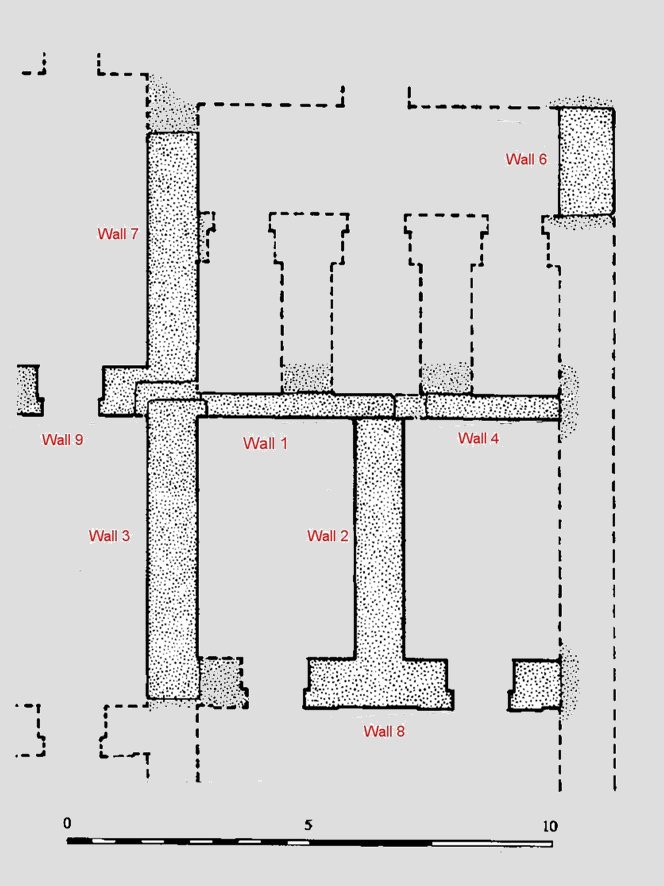
| Based on the blocks recovered up to now the chapel obviously had been dedicated to Amun only.
This my indicate that this monument had been built in the center of Karnak near
the chapel for the barque of Amun. |
| The remaining decoration allows to
identify four persons: Thutmosis II, Hatshepsut, Thutmosis III and Neferu-Ra -
but they do not appear together. Thutmosis II and Hatshepsut are shown
together, occasionally accompanied by Neferu-Ra who, on the other hand,
never is appears alone. Furthermore, Thutmosis III and Hatshepsut are
depicted together in one scene (Wall 2). In this scene both are shown
standing individually before Amun or its ithyphallic form, respectively,
i.e. king Thutmosis III and the God's Wife (and Great Royal Wife)
Hatshepsut both separately perform the rites.
|
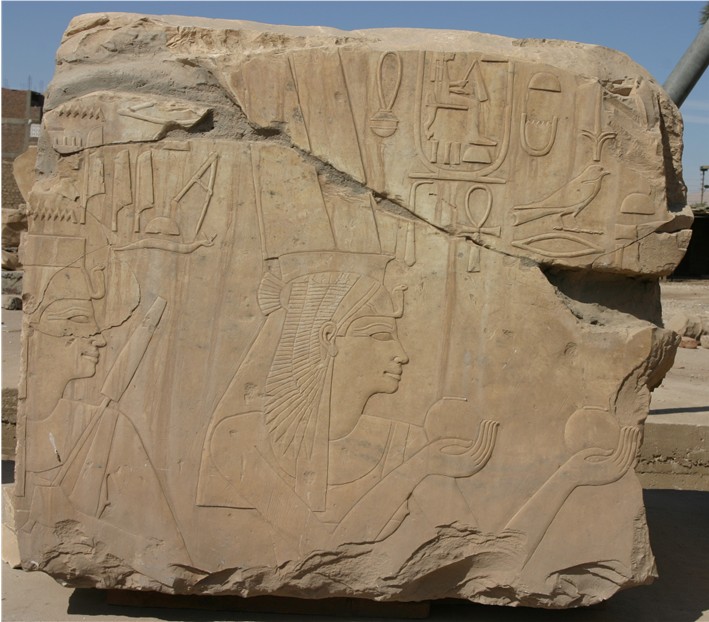
| The photo above shows the Great Royal Wife Hatshepsut offering
2 vessels, behind her her daughter, the God's Wife, Neferu-Ra
is shown (that this is Neferu-Ra is testified by the next block which shows the
cartouche with her name; Gabolde, 2005, plate XI). The rear side of the block is less good
preserved and shows the husband of Hatshepsut, Thutmosis II, seated an his
throne (Gabolde, 2005, plate X). |
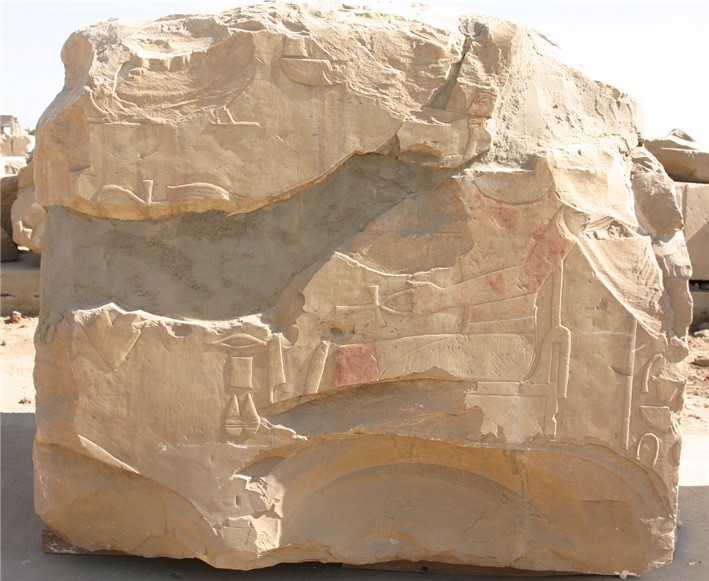
| A large number of the scenes shows traces of later changes of
the names and titles whereby most of the figures itself remained unaltered.
|
|
Several scenes show the names of Thutmosis II and that of his son written one
over the other (palimpsest). However, the name of Thutmosis III did
not replace that of his father as one would generally expect, but vice versa - Thutmosis III
had been replaced by Thutmosis II.
|
|
Furthermore, on some places the name of Thutmosis III had been replaced by the
name of Hatshepsut.
|
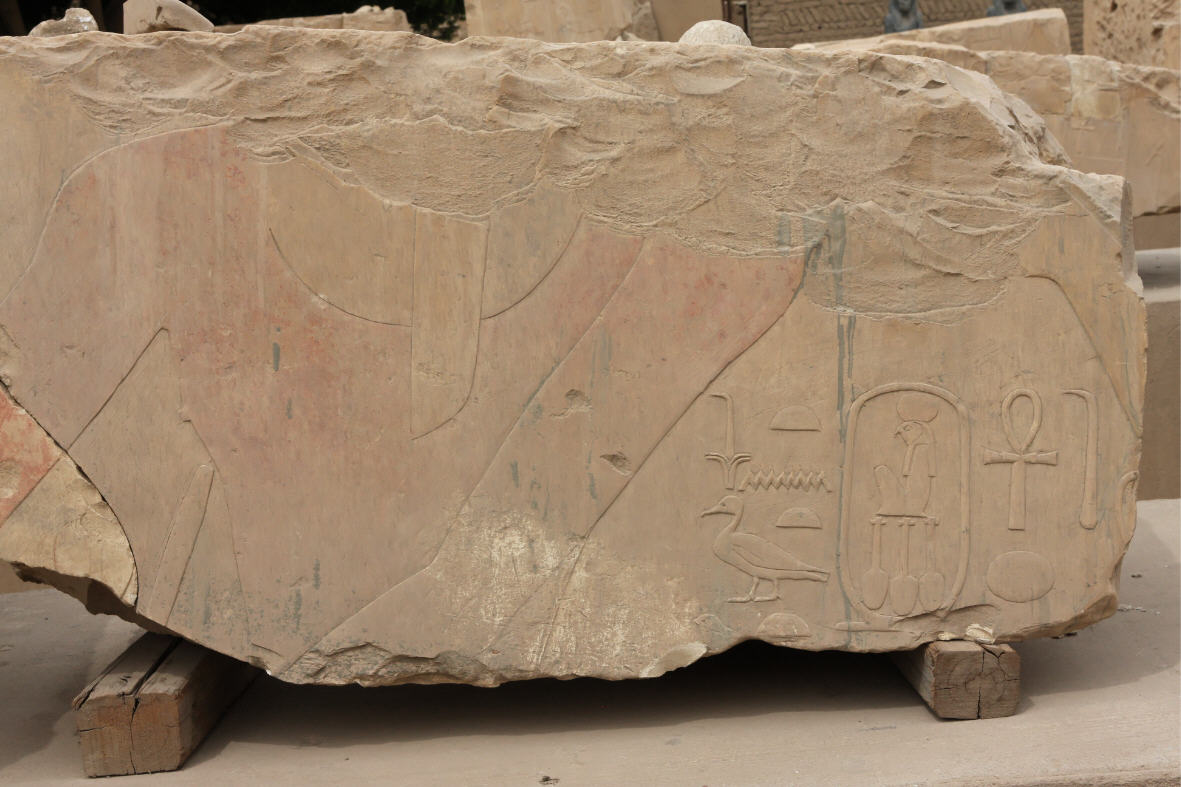
| The photo above shows a part of a scene from Wall 2. The scene shows Thutmosis II followed
by his little daughter princess Neferu-Ra (see name in the cartouche; Gabolde,
2005, plate III). To the
right the scene is continued on another block showing the "Great Royal Wife, Hatshepsut". |

| The photo above shows a part of Wall 7 (Gabolde, 2005, plate
XV) with 3 titles of Hatshepsut from the reign of her husband:
"King's Sister, God's Wife of Amun, Great Royal Wife". |
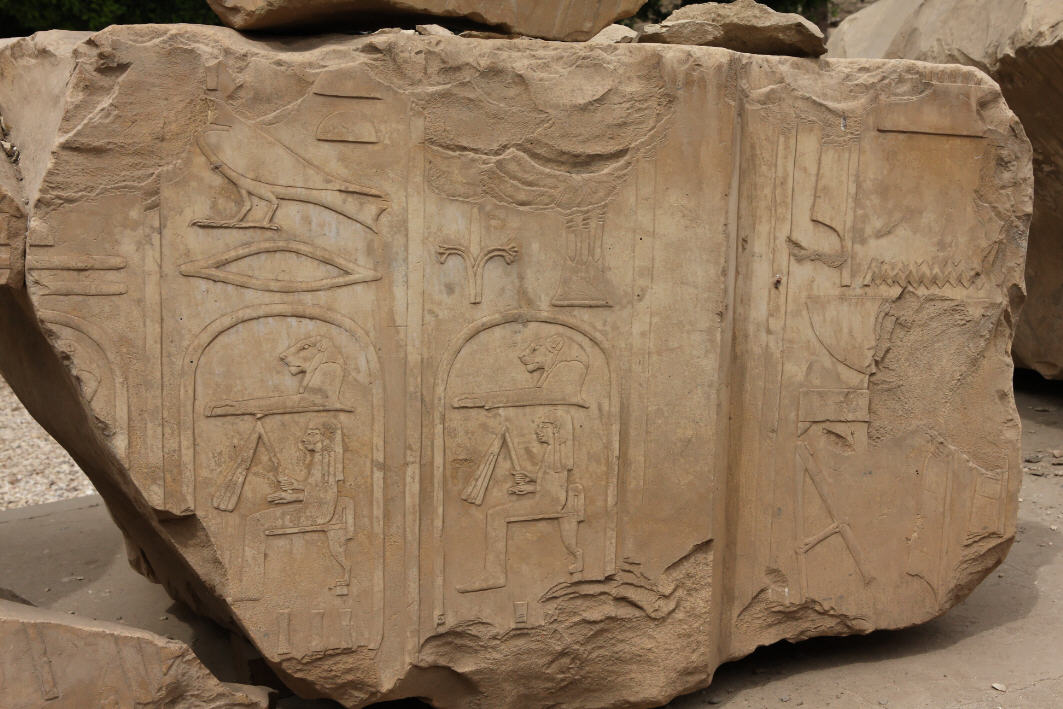
| The photo above shows a part of Wall 8 (Gabolde, 2005, plate
XVI) and shows three cartouches
- the left one ist nearly completely missing - of Hatshepsut from the reign of
Thutmosis II with the preceding titles "[Lady?] of the Two Lands [nb.? ]t tA.wj;
Great Royal Wife (= Hm.t nsw
wr.t); ??? of Upper and Lower Egypt (= ... ^maw MHw)". |
|
Only one single block shows traces of a change from Hatshepsut into
Maat-ka-Ra. The block is also unique in another aspect - it was discovered
re-used in the Ach-menu.
|
|
The sequence of the alterations suggests a start of construction work in the
first years after the death of Thutmosis II and the accession to throne by
his son, Thutmosis III. Correspondingly the building is listed also among
the temple personification on the lower register of the Red Chapel (western
gate,
Block
No. 131): " Temple of Men-kheper-Ra (called): " Amun, divine by [his]
monuments". |
|
We do not know anything about the idea behind these changes. However, assuming
that the period had been politically "unsafe" one might suppose a
"political" explanation: Thutmosis III had already succeeded his father on
the throne but the importance [of the reign of] Thutmosis II should be
emphasized posthumously and those of his son and successor reduced.
|
| Likewise, the changes of Thutmosis III into Hatshepsut also
indicate that this action had have taken place in the first years of the
reign of Thutmosis III, i.e. when Hatshepsut had been Queen Regent. Here too
the changes may have been done to upvalue the former Great Royal Wife of
Thutmosis II and the actual Queen Regent for Thutmosis III.
|
|
Beneficiary - and therefore also the initiator - of these actions could have
been Queen Regent Hatshepsut, maybe that these actions were part of the
prearrangements before her seizure of power. |
|
The following two representations show Thutmosis II or the God's Wife
Hatshepsut. Gabolde (Gabolde, 2005, plate XLI) located both scenes in two neighboring niches which were
part of the southern wing of the western wall of a "Great Ceremonial Court"
built by Thutmosis II and which opened into the court (i.e. to the east). |
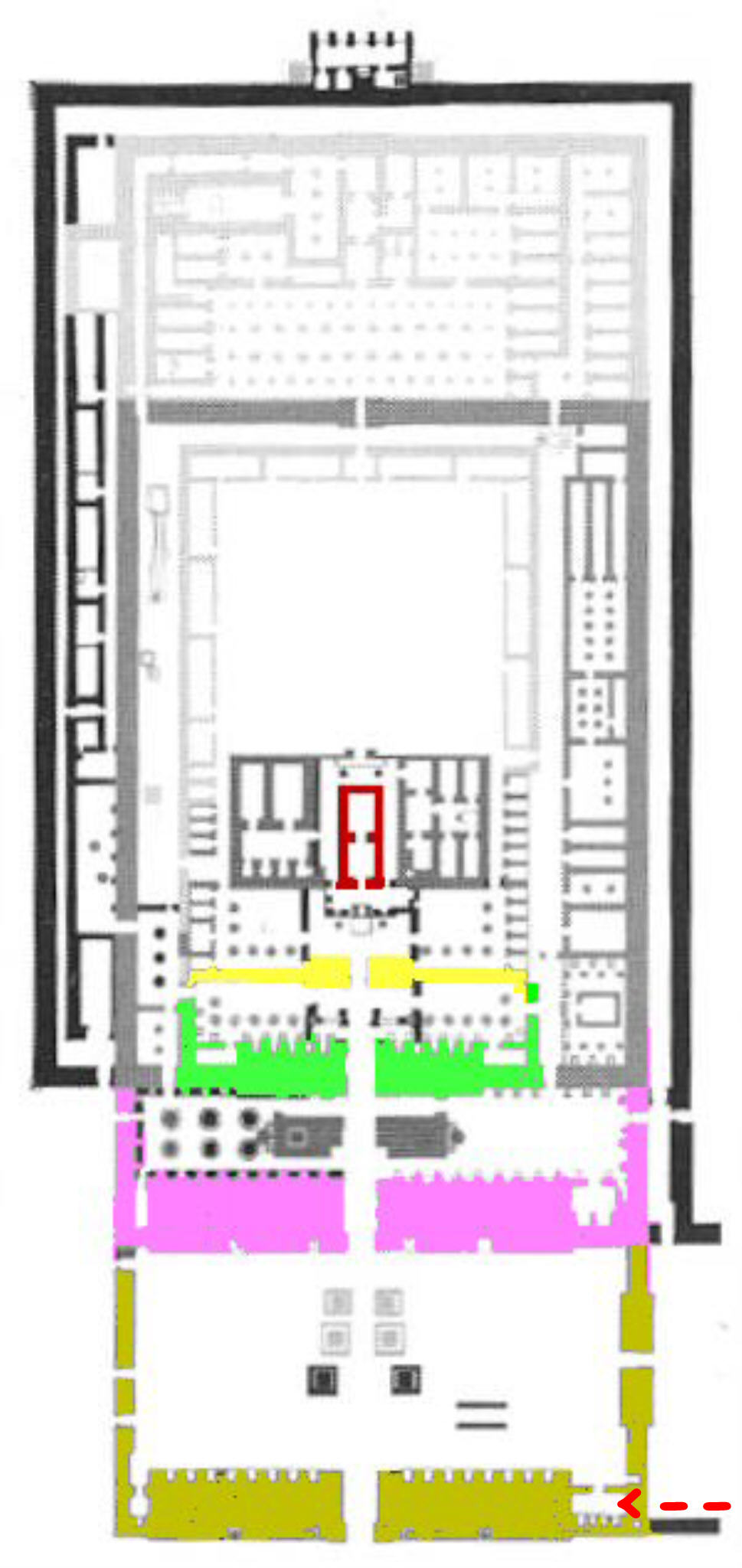
|
The red arrow in the plan above points to the "Chapel with niches" in the southern wing of the
western wall of the "Great Ceremonial Court" (modified plan according to Larché,
2007). |
|
The third niche was dedicated to Neferu-Ra and shows the "Daughter of the
King, the King's Sister", between a cow-headed Hathor (on the left) and Amun
(on the right). This block had been mounted for some times in the southern stone-store
at Karnak.
|
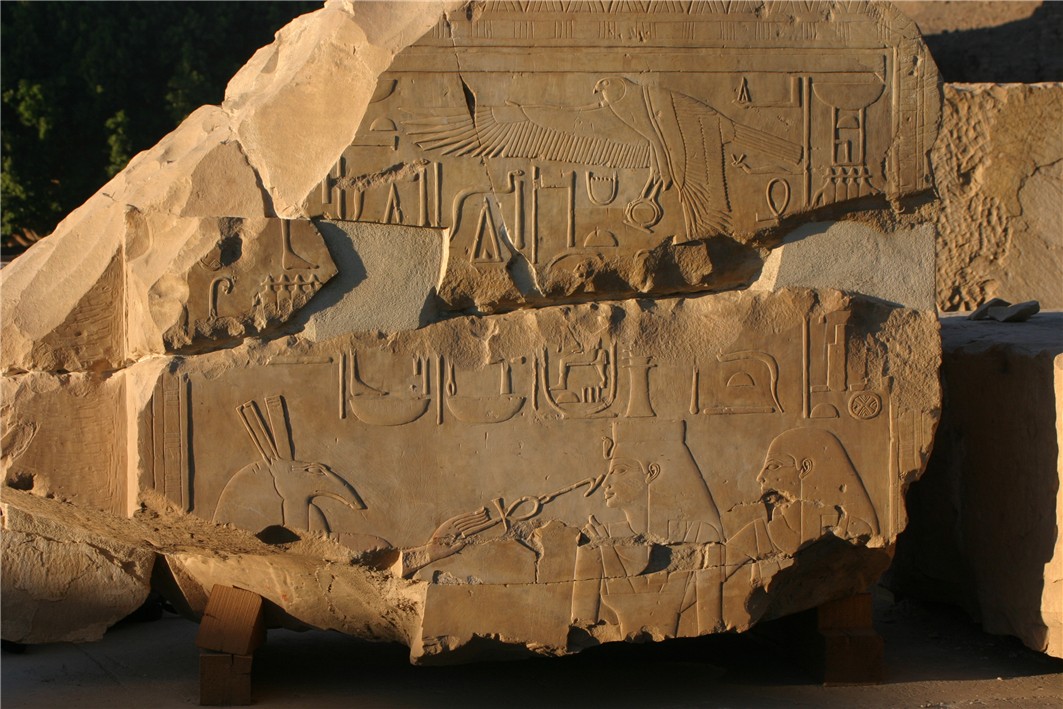
| Both photos (above and below) show a block
which is on display today in the OAM. On side (photo above) shows the God's
spouse (Hmt nTr)
Hatshepsut receiving "life" from Seth, the "One from Ombos who rules over
the south" and who is embraced by Nephthys, "who rules Karnak" (on the left. |
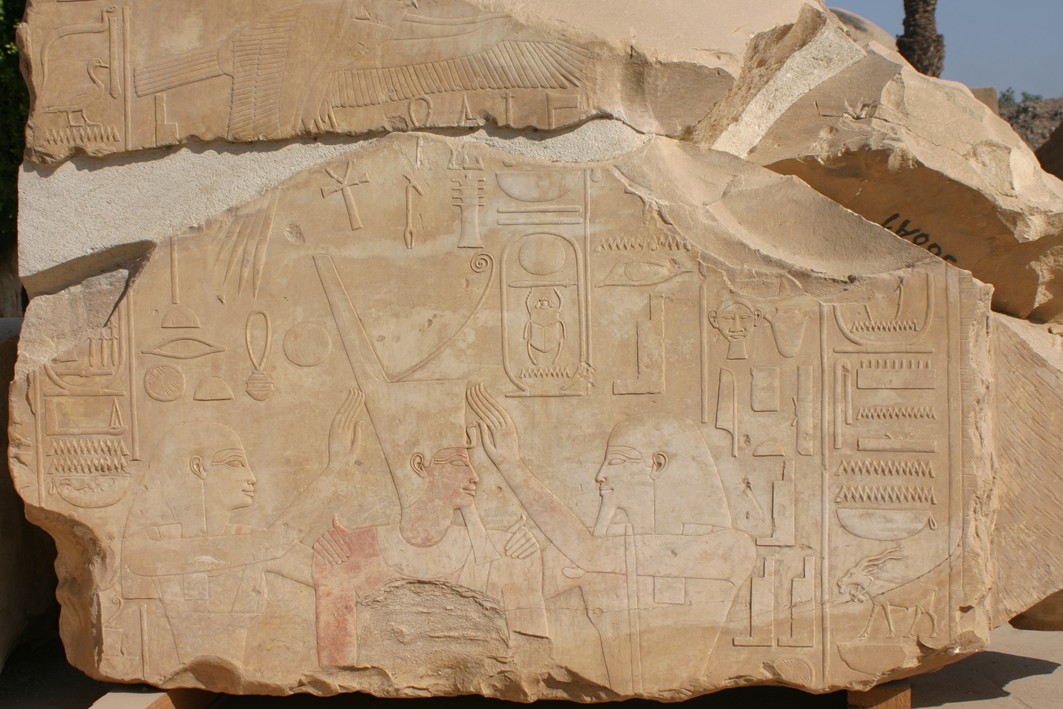
|
The other side of the block shows Thutmosis II is given the Red Crown by Osiris (right), "Hrj-ib
Ipt-swt = who
resides at Karnak" und Isis (left), "the Divine".
|
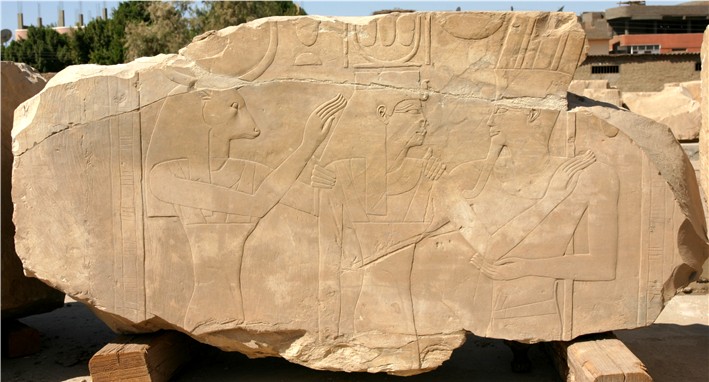
|
The photo above shows a block which is also a part of the "Chapel with niches"
(Gabolde, 2005, plate XLII).
The scene shows the God's Wife, Neferu-Ra, as testified by the remains of her
cartouche, led by the goddess Hathor (left) to Amun (right) who embraces the
princess (today the block is on show in the southern stone magazine at Karnak). |
|
As far as it is possible on the low number of fragments that have survived
Gabolde (Gabolde, 2005, plate XXXVI) reconstructed a rectangular building with two rooms (about 5 m wide,
more than 6 m long, and about 6 m high) that may have looked like the Red
Chapel of Hatshepsut.
|
| The fragments only show Thutmosis II and Hatshepsut, neither
Thutmosis III nor Neferu-Ra could identified on the remains of thee building.
|
|
The following blocks show Thutmosis II who presents 2 bulls and one calf - most
likely the original scene showed 2 - to Amun. The king wears the Double
Crown (Pschent), the royal apron, a collar decorated with two crossed falcon
wings, and in the right hand a staff.
|
| Behind Thutmosis II Hatshepsut is depicted. A fan carried by
an anx-sign protects the royal
couple. The blocks continue on the right with the remains of a scene in
front of the ithyphallic Amun.
|
| The fact that
Thutmosis II is performing the rites before Amun while Hatshepsut stand
behind him, and that Thutmosis III is missing in all remaining scenes of the
sanctuary, suggest that the building had been erected during the reign of
Thutmosis II. |
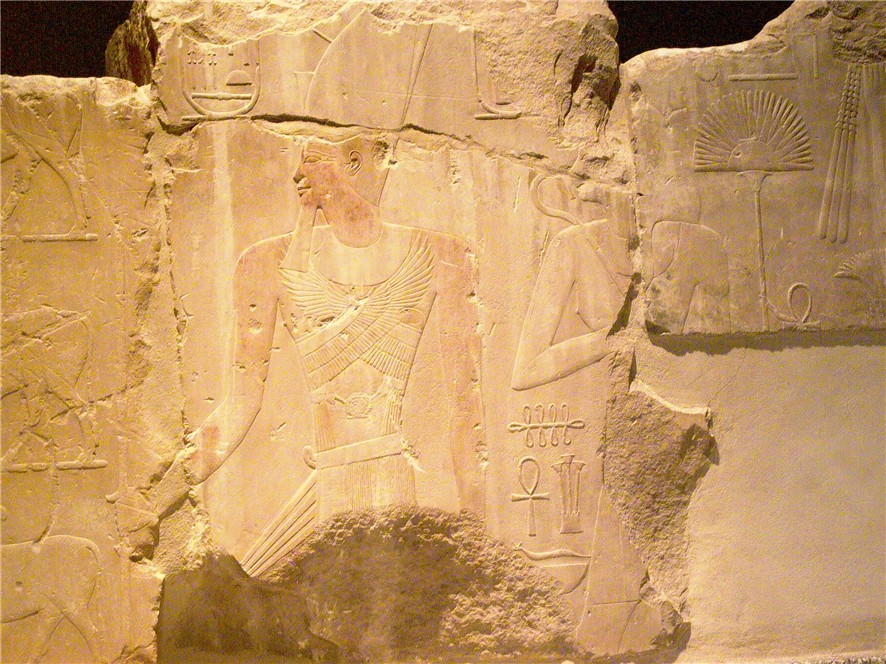
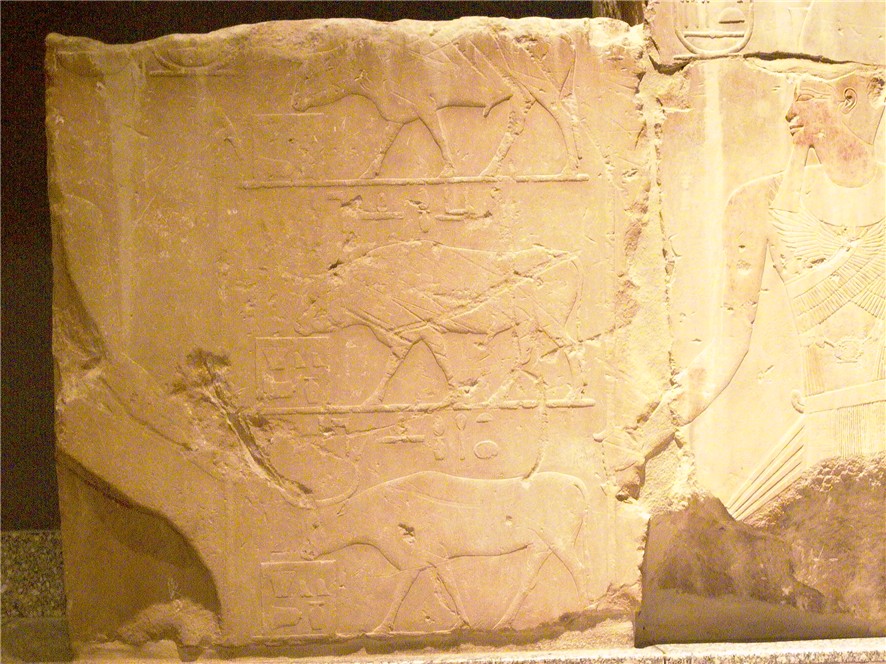
|
Thutmosis II followed by Hatshepsut presents 2 bulls and 2 calves to Amun;
all blocks are on display in the Luxor-Museum; site of discovery unknown,
most likely in the Court of Cachette. |
|
The representation of Hatshepsut deserves special interest. Quite obviously it
was changed afterwards, i.e. presumably during her regency. Catching one's
eye are the remains of the cartouche with her throne name "Maat-ka-Ra" which
she certainly has not used as Great Royal Wife of Thutmosis II. In addition,
the shoulders were widened to get a more "masculine" appearance, the wig was
converted into a "nemes" headscarf, and the scepter of the king's wife was
converted into a HqA-scepter. The right
leg was pulled forward to change the presentation from a figure resting on
its closed feet to a presentation of a walking person. The remaining part of
the right leg also shows short above the knee
the edge of a simple, tightly fitting dress. Traces of the dress are also to
be recognized by the left shoulder strap. |
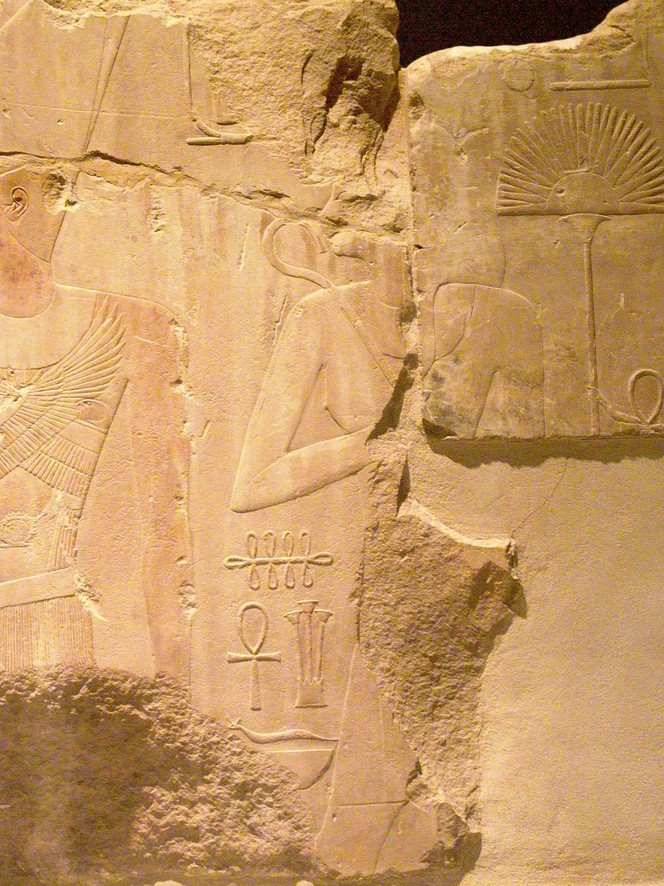
|
Modified presentation of Hatshepsut |
| Only a few limestone blocks of the 4th building have survived.
Two blocks were published by Labib Habachi, they fit to each other and show
beside the scepter of Amun in 6 columns of text an eulogy of Maat-ka-Ra /
Hatshepsut. According to Gabolde (2005) the cartouche had been recarved
replacing Hatshepsut by Maat-ka-Ra. |
| One limestone block each has been located in the Brooklyn
Museum, New York (Inv. No. 87.1), resp., in the Egyptian Museum Cairo (JE
40640). The block in New York shows fragments of the face of a royal or
divine figure. The block in Cairo shows the remains of the titles of
Maat-ka-Ra and Thutmosis II, the latter one has been partially destroyed. |
| The 4 limestone monuments identified from
blocks scattered over Karnak throw light on the time of upheaval at the
beginning of the new empire.
|
| Between the death of her brother and husband
Thutmosis II and her own acceptance of the royal power in the regnal year 7
of Thutmosis III Hatschepsut has taken over the regency from which one
willingly suppose that she formed it actively. However, little was known up
to the present time, because it is only very poorly documented on the
monuments.
|
| These four buildings - the "NTrj
mnw = Divine monument", the small
Chapel with niches which was dedicated to the
cult of some members of the royal family,
(Barque?-)Sanctuary, and, at least, the small
chapel of which only fragments have been preserved - give some clues which
possibly allow to show that the transition of Hatshepsut from the position
of the royal widow and regent of the kingdom to that of the Pharaoh took
place very progressively, and furthermore that the queen seized extremely
early - maybe even already during the last months of the rule of Thutmosis
II - certain royal prerogatives. |
|
In addition, the investigations give rise to check once more the
historical frame of this period. They specifically referred on royal titles
which had been the targets of - in some way unexpected - revisions, e.g. the
exchange of the name of Thutmosis III by that of Thutmosis II, and the
"progressive masculinization" of Hatshepsut. These investigations allowed
rather exactly to record in which steps the royal rights were transferred
gradually to Hatschepsut - until she achieved the full power of Pharaoh. |
|












